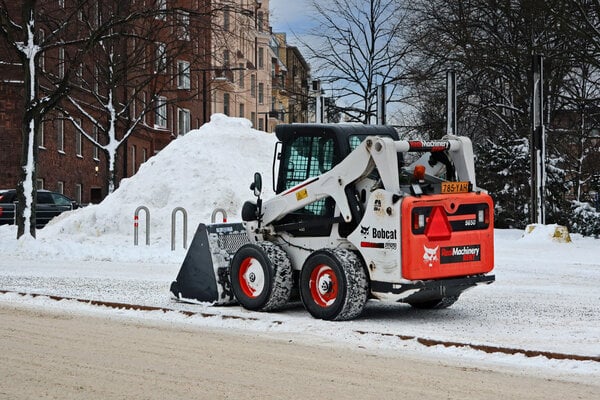Protecting hydraulic components from cold weather conditions is crucial. Hydraulic fittings, hoses and other components can become brittle, seize up or clogged during the frigid winters. Whether on oil and gas equipment, offshore rigs, or construction machinery in freezing environments, preventing hydraulic components from exposure to harsh temperatures is crucial. In cold weather conditions, hydraulic lines and reservoirs must be insulated to maintain the components’ rated temperatures. Furthermore, fittings can become clogged if the fluid is viscous, though hydraulic fittings themselves can withstand very cold temperatures, whereas:
- Brass fittings are rated at -325°F (-198°C)
- Carbon steel can withstand -65°F (-54°C)
- Stainless steel fittings are suitable as low as -425°F (-254°C)
However, low-temperature extremes can have an adverse effect on hydraulic fitting accessories such as O-Rings. Though O-ring boss and O-ring face seals are extremely popular for leak-tight seals, their O-ring materials are far more susceptible to cold temperatures.
The table below shows the lowest recommended temperature exposure of the most popular O-ring materials.
|
Lowest Recommended O-Ring Temperature |
O-Ring Material |
|
-15°F (-26°C) |
Fluorocarbon (FKM, Viton®) |
|
-15°F (-26°C) |
Perfluoroelastomer (FFKM) |
|
-175°F (-115°C) |
Silicone (VMQ) |
|
-30°F (-34°C) |
Nitrile (Buna-N, NBR) |
|
-40°F (-40°C) |
Polyurethane (AU) |
|
-5°F (-21°C) |
Polyacrylate |
|
-60°F (-51°C) |
Neoprene |
|
-70°F (-57°C) |
Ethylene Propylene (EPDM) |
|
-75°F (-59°C) |
Butyl |
|
10°F (-12°C) |
Fluorinated Ethylene Propylene (FEP) |
|
10°F (-12°C) |
Perfluoroalkoxy (PFA) |
|
-425°F (-254°C) |
Teflon® (PTFE)
|
While temperature is critical in O-ring selection, other factors such as application, pressure and media are significant considerations. Although the selected O-ring material may be rated for sufficient low temperature for the application, fluctuations from below to above freezing can cause the material to become dry and brittle.
Effects of Cold Weather on Hydraulic Hose and Other Components
In some cases, crews may go off-line during the winter. If equipment is left outdoors or in unheated garages hydraulic fluid must be drained from the system, particularly the hoses. The hose should be stored in a dry place at a reasonable temperature to avoid freezing and thawing because even when drained, moisture may still be present causing cracks in the hose.
While most hydraulic hoses are rated for - 40°F (-40 °C), varying temperature changes can cause issues. Even if heavy equipment is in frequent operation during the winter, frost, ice, snow and cold winds can result in complications with hoses. Exposure to extreme cold, particularly during an extended period can adversely affect the bending performance of hydraulic hoses, leading to cracks and leaks. Similarly to O-rings, fluctuations in temperature such as operating above freezing during the day and sitting idle below freezing at night will cause the hose to become stiff, brittle and inelastic. Over time, this can lead to cracks or degrade the hose cover and sleeve.
According to Angie Johnson of North Dakota State University; “The temperature of a piece of machinery can fluctuate from -20 degrees Fahrenheit to 200 degrees Fahrenheit in a matter of minutes. The hydraulic hoses on tractors and implements [and other heavy equipment] used in the winter months must be in prime condition to withstand the extreme temperature changes we face in the northern Plains.”
Hydraulic System Operating Conditions in Low Ambient Temperature
Cold temperatures can be devastating to hydraulic systems. Dangerous conditions for hydraulics can result from operating in below-freezing ambient temperatures or at high altitudes and in low atmospheric environments. One of the primary negative results of cold conditions is the impact on the viscosity of hydraulic fluids. Cold temperature extremes will make hydraulic fluids, additives and lubricants thicker due to increased viscosity, ultimately causing permanent damage to components and potentially the entire system. For instance, an excessive increase in viscosity will restrict the oil from quickly and evenly distributing around critical parts which may result in them seizing up.
If equipment remains idle in consistently cold temperatures fluids can actually congeal and stop flowing, eliminating flow to pumps, ceasing lubricating properties and causing cavitation. Any of these will lead to component failure and expensive damage to hydraulic equipment.
Rubber and other elastomeric materials are used throughout hydraulic systems, from hydraulic hoses to O-rings and seals for various components, including cylinders. As hydraulic systems become exposed to cold temperatures, these elastomeric materials, mounts, hydraulic fittings, and hoses can suffer severe damage. Though scheduled maintenance is essential, more frequent inspections should be performed when systems operate in extreme conditions. Elastomeric components in cold or fluctuating temperatures should be frequently checked for tears, cracks or leaks before re-starting the system. It’s also a good idea to keep an inventory of replacement parts on hand, such as fittings, seals and hoses.
Because hydraulic hoses can become permanently damaged, brittle and less flexible due to wide fluctuations in temperature, they will be prone to cracks, damaged seals, and leaks, leading to failed components and attachments. Although most hydraulic hoses are designed to withstand cold weather, it’s best to use caution to protect and extend the equipment, components, fittings, and hose service life.
To protect against cold or fluctuating temperatures consider:
- Using protective sleeves
- Maintain hydraulic systems and hoses according to the manufacturer’s recommendations
- Make sure to use the correct hydraulic fluid for weather conditions
- Put weather barriers such as protective wraps around hoses and fittings
Conclusion
Just as we should warm up our cars before driving in cold temperatures, it’s also vital to let hydraulic equipment warm up due to changes in fluid viscosity from sitting overnight. Let it idle for a while so the fluid in the hydraulic system can warm up. Cold weather increases the viscosity of hydraulic fluids causing it to take longer to circulate through the system, which lowers the ability to protect against wear until the fluid is at recommended flow.
Using the appropriate fluid for cold weather conditions, such as ISO 22 Cold Weather Hydraulic Oil, is continuously essential. Also, take into account atmospheric pressure if at high altitude. If in doubt about which fluid to use, check the manufacturer's guidelines for the appropriate fluids for cold temperatures.
Since you seemed interested in our instrumentation content, check our free BluePrint as a helpful resource:
Sources Include:


